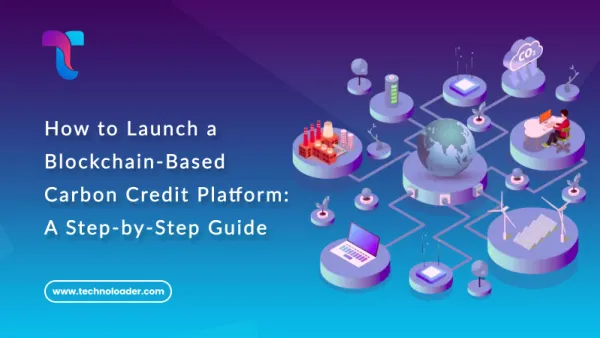How to Launch a Blockchain-Based Carbon Credit Platform: A Step-by-Step Guide

Strong 8k brings an ultra-HD IPTV experience to your living room and your pocket.
Introduction
Ready to launch a blockchain carbon credit platform and advance climate action? This step-by-step carbon credit platform guide walks you through how to launch a carbon credit platform in 2025. From understanding decentralized carbon markets to leveraging tokenized carbon credits and navigating India’s carbon market regulations for blockchain platforms, we’ve got you covered. Explore the benefits of blockchain for sustainable blockchain development, smart contracts for carbon credits, and carbon credit transparency. Whether you’re aiming for a carbon credit exchange platform or carbon offset platform development, this roadmap will empower your Web3 carbon solutions journey!
✍️ Curious about the role of blockchain in financial services? Read our guide on blockchain in finance to understand how DeFi, cryptocurrencies, and CBDCs are shaping the future of money.
Understanding the Landscape: Why Blockchain for Carbon Credits?
The Problem with Traditional Carbon Markets
Traditional carbon markets face challenges such as lack of transparency, double counting, and complex verification. Emitters, project developers, and buyers struggle with trust and efficiency in trading carbon credits – whether offsets or allowances. The blockchain carbon credit platform launch addresses these issues with immutable records and decentralization.
Benefits of Tokenized Carbon Credits
So, why should we consider building a blockchain platform for carbon credits? Here’s why tokenized carbon credits are a game-changer:
- Transparency: Every single transaction is recorded on the blockchain, making it visible to everyone.
- Traceability: With monitoring, reporting, and verification (MRV) on the blockchain, we can ensure that the data is correct.
- Accessibility: A decentralized carbon marketplace allows users from around the world to participate in trading.
- Efficiency: Smart contracts streamline the processes of issuing, trading, and retiring carbon credits.
Navigating India’s Regulatory Framework for Carbon Credit Platforms in 2025
Key Indian Regulations: CCTS and BEE Guidelines
India’s commitment to achieving net zero is driving the development of its blockchain carbon marketplace. The Carbon Credit Trading Scheme (CCTS) in India, established under the Energy Conservation (Amendment) Act, 2022, and managed by the Bureau of Energy Efficiency (BEE) and the Ministry of Environment, Forest and Climate Change (MoEFCC), sets rules for both compliant and voluntary markets. Ensure your carbon credit registry is compliant with these standards.
Addressing VDA Taxation for Tokenized Carbon Credits
In India, tokenized assets may be classified as virtual digital assets (VDAs), which may impact the taxation of carbon credits. It is wise to consult experts to ensure that your blockchain carbon platform meets regulatory requirements, especially with potential SEBI regulations for tokenized carbon credits and the EU’s Carbon Border Adjustment Mechanism (CBAM) for exporters. Stay ahead of the voluntary carbon market in India’s blockchain landscape!
Step-by-step guide to developing your platform
Step 1: Defining the key features of your platform
Start your journey in blockchain carbon credit development by clearly outlining your goals:
- Registry: Develop a system for a carbon credit registry to keep track of projects and credits.
- Exchange: Establish a platform for trading carbon credits, where users can buy, sell, and retire credits.
- MRV: Let’s implement MRV on blockchain for real-time verification.
Think about the essential features of a blockchain-based carbon credit exchange, such as a user dashboard, wallet, and reporting tools tailored for ESG blockchain platforms.
Step 2: Choosing the right blockchain and tech stack
Choosing the right blockchain for carbon credits is crucial:
- Ethereum for carbon credits: It’s robust and perfect for smart contracts using Solidity.
- Polygon for carbon credits platform: It’s scalable, affordable, and environmentally friendly.
- Hyperledger Fabric for carbon traceability: A great fit for enterprise solutions.
- Corda for enterprise carbon solutions: It provides security for private networks.
Don’t forget to add IPFS for Carbon data storage, Oracle for real-time Carbon data, and Web3.js / Ethers.js for dApp interactions to create a seamless Web3 Carbon solution platform.
Step 3: Smart Contract Development for Carbon Tokenization
Creating a smart contract is essential for issuing carbon credits. Use Solidity for your carbon smart contract to:
- Tokenize the credits (think carbon credit tokenization platform)
- Automate trading and retirement
- Integrate with standards like VERRA, Gold Standard or Climate Action Reserve (CAR)
Be sure to audit the contracts for best practices to keep your carbon credit platform secure and free of vulnerabilities.
Step 4: Implement strong KYC/AML and security
Securely onboard users and projects:
- KYC (Know Your Customer) and AML (Anti-Money Laundering) checks
- Decentralized Identifiers (DID) for privacy
- Security protocols like 2FA and encryption
Following best practices for security will help build trust in your carbon offset platform development.
Step 5: Testing and Deployment
Test your platform for functionality, verify the carbon project on the blockchain and integrate carbon standards with the blockchain platform. Deploy via a DApp featuring a user-friendly UI/UX to encourage adoption.
Launch, Marketing and Post-Launch Management
When it’s time to launch, be sure to announce your blockchain carbon credit platform to project developers, companies and investors.
Launch: Announce your blockchain carbon credit platform launch to project developers, companies, and investors.
Marketing: Emphasize the benefits of blockchain technology to increase transparency in carbon credits and explore monetization strategies for a blockchain-based carbon platform through social media, webinars and strategic partnerships.
Post-Launch: Monitor performance, fine-tune the measurement, reporting and verification (MRV) processes on the blockchain and expand your climate tech platform. Tackle barriers to launching a decentralized carbon marketplace, such as ensuring liquidity and achieving interoperability.
Conclusion
This comprehensive guide to launching a carbon credit platform prepares you to launch your blockchain carbon credit initiative in 2025. From outlining the essential features of a blockchain-based carbon credit exchange to selecting the ideal blockchain for carbon credits and navigating the regulatory landscape of India’s carbon market, you are all set to promote sustainable blockchain development. Overcome the challenges of setting up a decentralized carbon marketplace and leverage the potential of a green finance platform. Collaborate with experts like Technoloader to build a secure and innovative carbon credit tokenization platform and become a leader in climate action!
Note: IndiBlogHub features both user-submitted and editorial content. We do not verify third-party contributions. Read our Disclaimer and Privacy Policyfor details.







